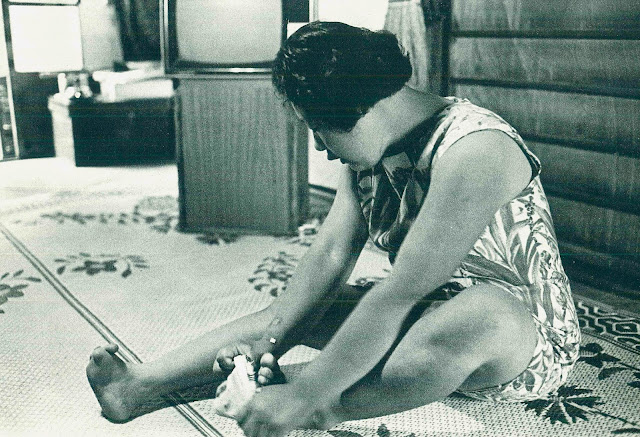Nobuko Kogusa, a 24-year-old girl who was exposed in utero to the Hiroshima atomic bomb, was born on March 7, 1946. Due to the explosion of the atomic bomb, the fetus, which had been in the mother's womb for about two months, suffered genetic damage caused by radiation. Microcephaly is a markedly small head circumference. Microcephaly, caused by early exposure to radiation from a short distance from the hypocenter, was recognized as an atomic bomb disease on September 7, 1967. It is accompanied by severe mental retardation, with a child's level of intelligence, which interferes with daily life and social activities. With multiple disabilities, he was born with a congenital deformity that resulted in the total loss of function of his right ankle joint. She is 24 years old, but her height is only about that of an elementary school student.
Eighteen parents and supporters of children with microcephaly who were exposed to the atomic bomb in utero have formed the Mushroom Association at P.O. Box 119, Hiroshima City Naka Bureau. The Atomic Bomb Casualty Commission (ABCC), established by the U.S. during the occupation, published a paper in 1952 on 16 disabled children with A-bomb microcephaly. The ABCC, which investigated and studied microcephaly in children exposed in utero in Hiroshima, explained to parents of children suffering from A-bomb microcephaly that it was caused by malnutrition during pregnancy. In 1965, through research by the Hiroshima Study Group, the parties discovered a 1952 academic English paper that provided scientific evidence for A-bomb microcephaly, and in 1965, the Mushroom Association of 18 children and parents with A-bomb microcephaly was formed. In 1965, 18 children and their parents with A-bomb microcephaly formed the Mushroom Association, and in 1967, thanks to the social activism of those involved in the Mushroom Association and others, the Japanese government recognized the causal relationship between A-bomb microcephaly and the atomic bomb and issued an A-bomb Survivor Certificate.
The name of the Mushroom Association comes from the phrase, "A life born under a mushroom cloud. Even if they live in the shade, we want them to grow up like mushrooms, pushing aside the fallen leaves" was the wish of the parents, children and supporters. The Mushroom Club for A-bomb Microcephaly suffered from the double discrimination of being an A-bomb survivor and a disabled person.







